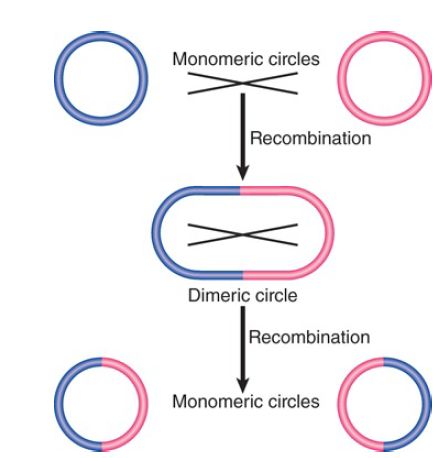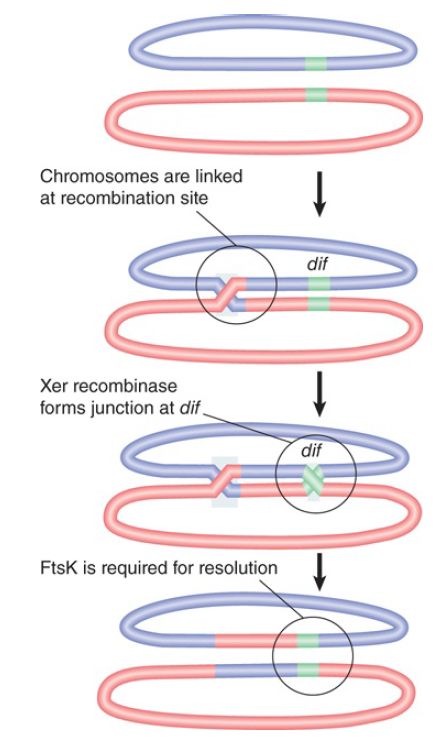


 النبات
النبات
 الحيوان
الحيوان
 الأحياء المجهرية
الأحياء المجهرية
 علم الأمراض
علم الأمراض
 التقانة الإحيائية
التقانة الإحيائية
 التقنية الحيوية المكروبية
التقنية الحيوية المكروبية
 التقنية الحياتية النانوية
التقنية الحياتية النانوية
 علم الأجنة
علم الأجنة
 الأحياء الجزيئي
الأحياء الجزيئي
 علم وظائف الأعضاء
علم وظائف الأعضاء
 الغدد
الغدد
 المضادات الحيوية
المضادات الحيوية|
Read More
Date: 15-12-2015
Date: 10-5-2016
Date: 15-3-2021
|
Chromosomal Segregation Might Require Site-Specific Recombination
KEY CONCEPTS
- The Xer site-specific recombination system acts on a target sequence near the chromosome terminus to recreate monomers if a generalized recombination event has converted the bacterial chromosome to a dimer.
- FtsK acts at the terminus of replication to promote the final separation of chromosomes and their transport through the growing septum.
After replication has created duplicate copies of a bacterial chromosome or plasmid, the copies can recombine. FIGURE 1 demonstrates the consequences. A single intermolecular recombination event between two circles generates a dimeric circle; further recombination can generate higher multimeric forms.
Such an event reduces the number of physically segregating units. In the extreme case of a single-copy plasmid that has just replicated, formation of a dimer by recombination means that the cell only has one unit to segregate, and the plasmid therefore must inevitably be lost from one daughter cell. To counteract this effect, plasmids often have site-specific recombination systems that act upon particular sequences to sponsor an intramolecular recombination that restores the monomeric condition. For example, plasmid P1 encodes the Cre protein-lox site recombination system for this purpose. Scientists have further exploited the Cre-lox system extensively for genetic engineering in many different organisms. These systems are also discussed in the chapter titled Homologous and Site-Specific Recombination.

FIGURE 1. Intermolecular recombination merges monomers into dimers, and intramolecular recombination releases individual units from oligomers.
The same type of events can occur with the bacterial chromosome; FIGURE 2 shows how such an event affects its segregation. If no recombination occurs, there is no problem, and the separate daughter chromosomes can segregate to the daughter cells. A dimer will be produced, however, if homologous recombination occurs between the daughter chromosomes produced by a replication cycle. If there has been such a recombination event, the daughter chromosomes cannot separate. In this case, a second recombination is required to achieve resolution in the same way as a plasmid dimer.

FIGURE 2. A circular chromosome replicates to produce two monomeric daughters that segregate to daughter cells. A generalized recombination event, however, generates a single dimeric molecule. This can be resolved into two monomers by a site-specific recombination.
Most bacteria with circular chromosomes possess the Xer sitespecific recombination system. In E. coli, this consists of two recombinases, XerC and XerD, which act on a 28-base-pair (bp) target site called dif that is located in the terminus region of the chromosome. The use of the Xer system is related to cell division in an interesting way. The relevant events are summarized in FIGURE 3. XerC can bind to a pair of dif sequences and form a Holliday junction between them. The complex might form soon after the replication fork passes over the dif sequence, which explains how the two copies of the target sequence can find each other consistently. Resolution of the junction to give recombinants, however, occurs only in the presence of FtsK, a protein located in the septum that is required for chromosome segregation and cell division. In addition, the dif target sequence must be located in a region of approximately 30 kb; if it is moved outside of this region, it cannot support the reaction. Remember that the terminus region of the chromosome is located near the septum prior to cell division .

FIGURE 3. A recombination event creates two linked chromosomes. Xer creates a Holliday junction at the dif site, but can resolve it only in the presence of FtsK.
The bacterium, however, should have site-specific recombination at dif only when there has already been a general recombination event to generate a dimer. (Otherwise, the site-specific recombination would create the dimer!) How does the system know whether the daughter chromosomes exist as independent monomers or have been recombined into a dimer? One answer is the timing of chromosome segregation. Remember that the terminus is the last region of the chromosome to be segregated. If there has been no recombination, the two chromosomes move apart from one another shortly after they are replicated. The ability to move apart from one another, however, will be constrained if a dimer has been formed. This forces the terminus region to remain in the vicinity of the septum, where sites are exposed to the Xer system.
Another factor that promotes separation of the terminus is the FtsK protein. Bacteria that have the Xer system always have an FtsK homolog, and vice versa, which suggests that the system has evolved so that resolution is connected to the septum. FtsK is a large transmembrane protein. Its N-terminal domain is associated with the membrane and causes it to be localized to the septum. Its C-terminal domain has two functions. One is to cause Xer to resolve a dimer into two monomers. It also has an ATPase activity, which it uses to pump DNA through the septum. A special type of chromosome segregation occurs during sporulation in B. subtilis. One daughter chromosome must be segregated into the forespore compartment. This is an unusual process that involves transfer of the chromosome across the nascent septum. One of the sporulation genes, spoIIIE, is required for this process. The SpoIIIE protein resembles FtsK, is located at the septum, and has a translocation function that pumps DNA through to the forespore compartment.



|
|
|
|
تفوقت في الاختبار على الجميع.. فاكهة "خارقة" في عالم التغذية
|
|
|
|
|
|
|
أمين عام أوبك: النفط الخام والغاز الطبيعي "هبة من الله"
|
|
|
|
|
|
|
المجمع العلمي ينظّم ندوة حوارية حول مفهوم العولمة الرقمية في بابل
|
|
|